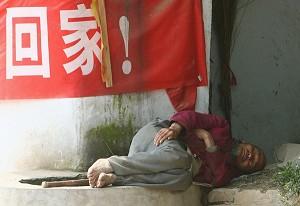BEIJING— China Youth Daily recently published the results of a Sina Net survey it conducted. Of the 5,690 people interviewed, 98.3 percent felt that the gap between the rich and the poor in China had increased compared with what it was 10 years ago. Eighty four percent considered the current extreme disparity unacceptable.
Most People Believe the Government Should Increase the Wages of the Low Income Group
When asked how to reduce the income disparity, 73.5 percent of people responded that [the government] should increase the wages of the low-income groups rather than heavily tax the high-income earners.
The Southern Weekend did a survey of wealthy residents in China. The results showed that most of those surveyed think that money has brought them a state of insecurity. Tang Jun, researcher at the Chinese Academy of Social Sciences, said that people should pay attention to the extreme disparity between the incomes of the rich and the poor in China. This isn’t alarmist talk but sensible advice.
‘Resenting’ the Rich
The Beijing Daily quoted Mao Shoulong, director of the School of Administrative Management at Renmin University in China. Mao said that the resentment of the rich in China has a deeper, alternative meaning. It is actually resentment of unfair treatment. Many poor people are the victims of inequality. The newspaper article also pointed out that many rich people benefit from the inequities.
Yang Fan, professor of the Business School of the China University of Political Science and Law, said that the disparity between rich and poor in Chinese society was increasing and is not good for the consumer market. Farmer’s incomes are just starting to increase but the gap is still huge. It’s hard for the farmers to move into the mid-range of the consumer market.
Yang said, “This fundamental problem in China came from disproportionate income allocation. The poor get poorer and the rich get richer. The first thing to do is to regulate income allocations and stop the gap between rich and poor from getting any larger.”
Income Disparity Exists in Rural Areas Too
The extreme disparity in China occurs not only in the urban areas but also in the rural areas. According to China Youth Daily, the Department of Sociology of the School of Journalism and Communication of Nanjing University conducted a survey in some rural areas in May 2006. Among the 20 villages surveyed, Huaxi Village of Jiangsu Province had the highest average annual income per person, 18,820 yuan (approximately US$2,330), in 2005. Nanniwan Village in Shanxi Province had the lowest, 1,526 yuan (approximately US$190). The average annual income of residents of the first village is almost 12 times higher than those in the second village.
Chen Xin, a researcher from the Sociology Research Institute of the Chinese Academy of Social Sciences, said, “In the next 10 to 30 years or longer, our biggest mission will be to solve the relative deprivation issue. That is, the comparative inequality in consumption and in access to services and public utilities because of the imbalanced income distribution and regional developments. This is a huge task.”
At the end of July, the China National Development and Reform Commission predicted that in the next six months, the disposable income of farmers will continue to decline and the disparity between the incomes of rural and urban residents will continue to rise. It’s been more than 20 years since China started the “reform and open policy.” The income distribution problem and the differences in incomes between regions continue to be a hot topic in Chinese society.

